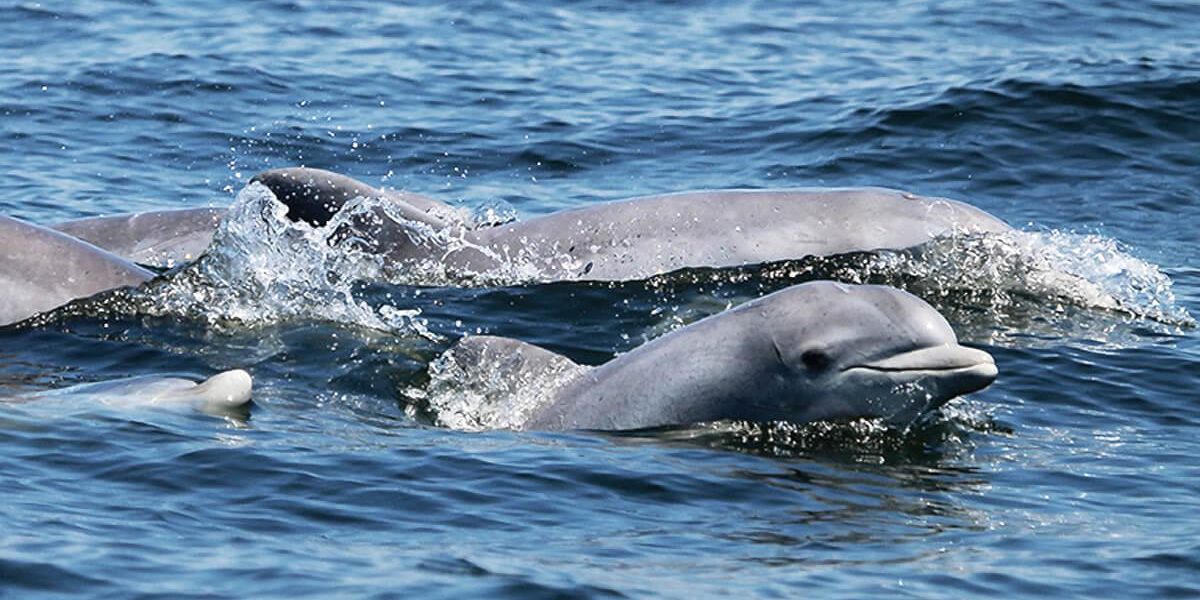News & Community
Talk of the Bay
Potomac-Chesapeake Dolphin Project surveys dolphins in about 14 square miles of the Potomac.
Janet Mann had been studying dolphins in Australia’s Shark Bay for several decades when her husband suggested buying a cottage off the Potomac River in Virginia’s Northern Neck several years back as a dolphin-free retreat.
“I resisted it,” Mann explains with a chuckle. “It was my husband’s idea. He thought I worked too much and wanted a getaway place for us. Literally the day we close on the house, there are dolphins in our backyard.”
A professor of biology and psychology at Georgetown University, Mann thought the dolphin sighting was an anomaly. No scientific literature on the mammals in the Chesapeake Bay existed, let alone in the Potomac River. But so many kept popping their bottlenoses up behind Mann’s “escape” cottage, she soon turned it into a field station. “My husband is a patient man.”
Following a dolphin die-off in the Bay caused by a virus outbreak, Mann and her research team launched the first-ever formal study of the local population in 2015. That effort grew into the Potomac-Chesapeake Dolphin Project, which today surveys the social and super-smart mammals from May through October in about 14 square miles of the Potomac. They’ve documented dolphins up river as far as the Harry W. Nice Bridge in Charles County, about 75 miles south of Baltimore. (The distressed dolphin that died in the Inner Harbor last year was a peculiar incident; normally they come no closer than the mouth of the Patapsco.)
A year ago this month, researchers witnessed a dolphin giving birth in the Potomac. It’s believed to be one of only three times scientists have seen a bottlenose dolphin giving birth in the wild anywhere. Ann-Marie Jacoby, the assistant director of the Potomac-Chesapeake Dolphin Project, was trailing a group of 50 dolphins in the lower section of the river when a cloud of blood floated to the water’s surface.
“At first, it was alarming,” Jacoby recalls. “I thought, ‘Did we hurt one of them? Was there a shark?’” Then she saw another cloud of blood and a “slightly bent and still wobbly fin” surface near an adult dolphin.
Dolphins, as Mann, an expert in animal behavior, notes, live long lives—40 to 50 years—and possess an extraordinarily cognitive ability, with a brain-to-body weight ratio greater than great apes and second only to human beings. They are natural learners, cooperative, and able to adopt new foraging and hunting strategies. Some use tools, placing sponges on the ends of their snouts as they rummage through the ocean floor.
Their sonar, which can detect the difference between a ping-pong ball and a golf ball from hundreds of yards away based on its density, is the envy of the U.S. Navy. But it is their facility for “conversation,” as some scientists characterize it, through clicks, whistles, and body language, plus the lasting bonds formed with each another, as well as their playful and charming personalities, that make them both endearing and fascinating. Dolphins even “name” themselves by listening and then developing unique signature whistles.
In truth, sightings in the Bay and Potomac are not new. In July 1844, a pod of dolphins was spotted swimming near the Capitol in Washington, D.C. Others were seen in the 1880s in the river near Alexandria, Virginia. After that, sightings in the Potomac evaporated as pollution began to destroy the condition of the river. A half-century of clean-up and restoration now appears to be helping bring them back.
Since 2017, Helen Bailey, a research professor at the University of Maryland’s Center for Environmental Science, has managed a cellphone app, DolphinWatch, which enables the public to log Bay-area sightings. Submitted photos are entered into sophisticated fin matching software (dorsal fins are akin to finger prints for dolphins) that can identify individual dolphins and follow their movement. So far, citizen scientists have uploaded more than 2,700 sightings.
It’s a challenge studying fast-moving marine mammals, Mann says, in that you can’t see everything they’re doing. There remains a lot of mystery, in terms of understanding their lives, what they are doing with their big brains, and “what it means to be a dolphin.”
“These are really big, powerful animals, yet human beings feel entirely safe around them. Small children will happily jump into the water with them,” Mann says. “I think that’s fascinating.”
